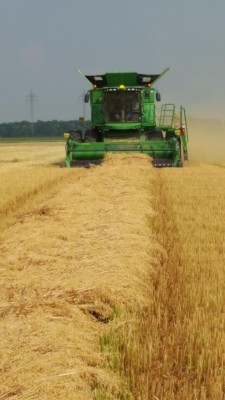Harvest time is nearly upon us in much of Western Canada. As you start your harvest prep, here are 5 tips from our team to ensure you are prepared.
1. Know Your Crops and Make a Plan
Make a rough outline of the crops and varieties you grew this year. Which crops will mature first, and if you grew multiple varieties of the same crop kind, which one(s) will turn faster? Did you have any fields damaged by severe weather, disease or insects? These fields might mature faster or have issues with lodging and might need to be bumped up the list. Alternatively, you may want to leave a damaged crop until later in the season, knowing it’s yield potential is already limited.
The ultimate goal is to develop a map for your order of harvest. Of course, you’ll also need to keep checking all fields for surprises in maturity and crop development.
2. Prepare Your Equipment
Likely the most obvious tip on our list, but quite possibly the most important. Don’t wait until the day before you expect to start harvest to pull your equipment out of the shed. Give yourself plenty of time to check machinery, augers, bins, trucks and grain dryers. Also take the time to prepare and calibrate your yield monitor. If anything isn’t ready to go, the downtime will cost you time and money.
3. Keep it Clean
The fall application of glyphosate is a widely used tool by many growers, but has come under increased scrutiny lately from negative consumer perceptions. What can you do to protect this important tool for years to come? (taken from www.keepingitclean.ca)
- Always follow the label. Labels on crop protection products have been developed through Canada’s science-based regulatory process. The labels ensure safe use of crop protection products and help ensure that residues do not become a marketing concern.
- Do not apply glyphosate to cereals when kernels are 30% moisture or greater in the least mature areas of the field.
- Abide by the pre-harvest interval.
- Some customers have contract limitations on fall application of glyphosate. Talk to your grain buyers to ensure they know what crop protection products you intend to use, and to confirm that none of these products will cause concern for export or domestic customers.
For all crops, make sure you are following the pre-harvest interval guidelines, and using only registered chemistry at the recommended rates. The Keep it Clean website is a great source of information - click here.
4. Keep Equipment Clean Too
With the growing threat of clubroot and other diseases like Goss’s wilt, cleaning your equipment between fields is an important prevention tool for future years. Clubroot spores are easily spread with soil residue from one field to the next, and Goss’s wilt can overwinter in crop residue.
5. Diagnose and Document Problems Right Away
Have a field that didn’t perform as expected? Your best bet is to try to diagnose the issue right away. It is a lot easier to find out whether the cause is related to disease, moisture, weeds, insects or simply variety performance during harvest then after the fact. This information will also help you to build a plan for next season’s crop.
Hopefully these few tips will help prepare for the season. Everyone at CANTERRA SEEDS wishes you a safe and productive harvest.


